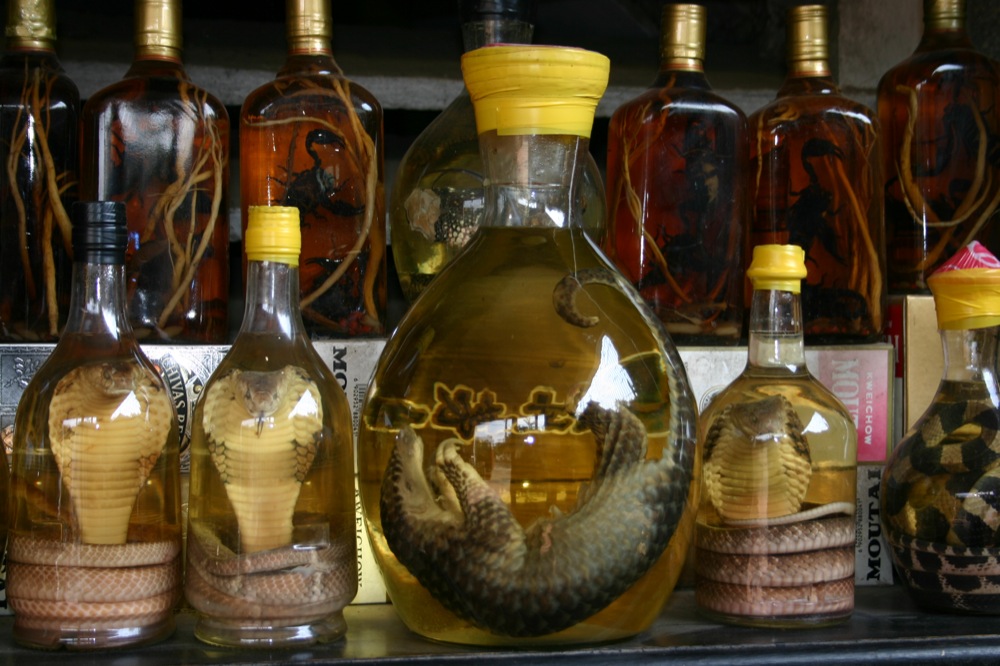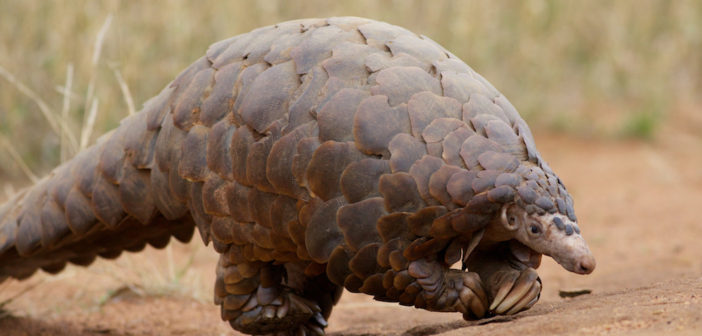(Featured image: wild pangolin in South Africa. Credit David Brossard, used under CC BY-SA 2.0)
Letter to:
Uganda Wildlife Education Centre
Plot 56/57 Lugard Avenue, Entebbe
Uganda Wildlife Authority
Plot 7 Kira Road, Kamwokya, P.O.Box 3530, Kampala, Uganda
__
20th September 2016
Dear Sirs/Madam,
We are writing to you on behalf of the International Union for Conservation of Nature (IUCN) Species Survival Commission (SSC) Pangolin Specialist Group, and African Pangolin Working Group and all the organisations listed below. The IUCN SSC Pangolin Specialist Group and African Pangolin Working Group comprise scientists with expertise on pangolin ecology and biology, veterinary health, genetics, trade in pangolins as well as leading experts on pangolin husbandry and captive care.
We would like to express our serious concerns over the recent proposal on “Experimental research on captive breeding of pangolins in Uganda” submitted by Mr. Zhong Shu Yong (Asia-Africa Pangolin Breeding Research Centre Limited) to the Uganda Wildlife Education Centre.
Pangolins are the most commonly confiscated wild mammals from the illegal wildlife trade, being trafficked in huge numbers for their meat, and scales which are used in traditional medicine within many countries. China has emerged as the biggest pangolin consumer in the world today. To meet the high demand, especially for the pangolin scales used in traditional medicine, many Chinese companies have suggested breeding pangolins in captivity for commercial purposes. This raises serious concern for pangolin conservation across the world globally.

Pangolin wine for sale in Hanoi, Vietnam (photo credit: squishyray, used under CC BY-NC 2.0)
Pangolin farming is not a solution for pangolin conservation for the following reasons:
1. Pangolins are hard to keep in captivity
Pangolins are a very difficult species to maintain in captivity. Over the last 160 years of record-keeping, more than 100 zoos and rescue centers have attempted captive management of pangolins with very limited success. The highest mortality rates are generally recorded in the first six months; only very few survive a few years in captivity. Typically, captive pangolins die within short periods of time owing to the poor acceptance of captive diets (as they have adapted to a highly specialized diet in the wild including ants and termites), digestive problems, stress and inappropriate housing conditions. Most newly arrived pangolins need diligent care and specialized nutrition in order to adjust to captivity and only a few individuals out of the many pangolins finding their way into captivity are able to survive the ordeal of captivity. The only pangolins that survive in captivity do so as a result of long periods of trial and error and the slow introduction of artificial diet formulations. It is highly unlikely that wild-caught pangolins would survive in the farm suggested by Asia-Africa Pangolin Breeding Research Centre Limited, as this company has not demonstrated any knowledge of the practical minutiae of pangolin captive care which comes with decades of experience and through strict adherence to the highest standards of animal welfare – a tough ask and one which is rarely achieved by a commercial farm.
2. Little reproductive success
There has been very little success of captive breeding of pangolins and very few pangolin births in zoos or breeding centers. Many facilities have attempted to breed the Asian pangolin species; however, only a few newborns have been reported in the last decade from zoos such as Taipei Zoo and Wildlife Reserves Singapore. A limited number of pangolins have been born in captivity to mothers already pregnant when they came into care but often these offspring and/or sometime even the mothers do not survive. This poor captive breeding record is a result of improper nutrition, poor acclimation, disease and lack of knowledge of pangolin reproductive biology. There is a lack of understanding of the mating behavior of pangolins which is known to be extremely complex and sensitive. For example, the South China Institute of Endangered Animals and Guangdong Provincial Wildlife Rescue Center (Guangzhou, China) have tried to breed pangolins from 35 individuals, yet only two of the 35 individuals survived for more than two years and there was no success in breeding at all. It would be much more difficult to breed African pangolin species as they are an even more difficult species to maintain in captivity and there are no successful breeding records.
3. Slow reproduction
Pangolins are both slow breeding and slow growing species and would therefore be very expensive to rear, meaning attempts at farming would not be profitable. Pangolins are believed to give birth to one young at a time, with a maximum of one birth per year. It is estimated more than a million pangolins have been hunted in the wild in the last decade for meat consumption and traditional medicine. Most recently 11 tons of pangolin scales from Africa were confiscated in Hong Kong between June – July 2016. Even if there is a potential for success in breeding pangolins in captivity, no farm in the world will be able meet the high market demand for pangolins. There is no scientific proof that pangolin scales have medicinal properties, and unfortunately this myth drives the demand for pangolins. Breeding pangolins for commercial purpose would create a legal market for pangolins which are already on the brink of extinction.
4. Law enforcement
Breeding pangolins in captivity would create potential problems for law enforcement of the illegal pangolin trade in Uganda and internationally. It is impossible to accurately distinguish wild pangolins from farmed pangolins. It would likely be even more difficult to combat the illegal pangolin trade if traders, restaurant owners or traditional medicine shop owners were to use wild caught pangolins in the guise of farmed ones. It would be more difficult still to distinguish whether pangolin products like scales or frozen meat were from farmed or wild pangolins. Needless to say, there are corrupt individuals and agencies who supply pangolin products to illegal markets, and creating a legal market would ease their activities. As with other species such as tigers, rhinos or Asian bear species, it might be that wild caught pangolins are seen as more desirable than captive reared, which would push the price of wild caught specimens even higher, increasing the incentive for poachers and traders.
5. Reintroduction problems
Even if Asia-Africa Pangolin Breeding Research Centre Limited were to breed pangolins and release a percentage of them back to the wild, this would bring potential risk to wild pangolin populations. These risks include introducing disease or inbreeding that would affect wild pangolin populations. There is no historical record of success for captive bred pangolin reintroduction programs. Therefore, the value of releasing any captive bred pangolins into the wild is questionable.
6. Laundering
Farming is not a solution for stopping or reducing illegal hunting of wild pangolins. Given the costs involved in housing and feeding pangolins, their slow reproductive and growth rates and the high mortality rates in captivity, it is difficult to see the investment value in such a proposition. The comparative costs of farming and hunting will be a key argument to answer the question of whether farming pangolins should or should not be permitted. As long as there is an accessible supply of wild pangolins, hunting will remain cheaper and provide quicker profits than farming pangolins. A key lesson learnt from many other wildlife farm enterprises is that farming wildlife actually increases the hunting pressure to supply wild animals to the farms, while making law enforcement for wild taken specimens more challenging. Ultimately, the risk associated with taking wild pangolins into captivity is too high given they are already in steep decline.
7. Low priority for conservation breeding
Representatives of over 190 governments and over a thousand conservation organizations from around the world came together at the IUCN World Conservation Congress (WCC) earlier this month in Honolulu, Hawaii. Among the priority conservation motions that the WCC members approved was Motion 011, called Greater Protection Needed for All Pangolin Species. See: https://portals.iucn.org/congress/motion/011. Significantly, captive breeding even by trained conservation/breeding experts is not one of the recommended conservation actions to help save pangolin species.
In summary, there is ample evidence from other taxa that farming pangolins for commercial purposes will likely be detrimental to pangolin conservation and pangolin populations in the wild. The IUCN-SSC Pangolin Specialist Group, African Pangolin Working Group and all of the signatory organizations below recognize that breeding pangolins for conservation purposes is a low priority, and they urge Parties not to support or promote any activities relating to commercial breeding.
We recommend that Uganda Wildlife Education Centre and the Uganda Wildlife Authority should decline the proposal from Asia-Africa Pangolin Breeding Research Centre Limited. We urge you not to grant permission for the pangolin breeding, thereby sending a clear message to the local and international wildlife conservation community so that they may continue to support the work you do.
Yours sincerely,
Daniel W. S. Challender
Co-Chair
IUCN SSC Pangolin Specialist Group
Darren Pietersen
Africa Vice-Chair: IUCN SSC Pangolin Specialist Group
Vice-Chairman: African Pangolin Working Group
Thai Van Nguyen
Captive Ecology Vice-Chair, IUCN SSC Pangolin Specialist Group
Executive Director of Save Vietnam’s Wildlife
Lisa Hywood
Founder and Board Member of African Pangolin Working Group
Founder and CEO of Tikki Hywood Trust
Sent on behalf of the following organizations
- Annamiticus – United States
- Animals Asia Foundation– United Kingdom, Hong Kong, Vietnam, Germany, Australia, Italy and New Zealand
- Animal Concerns Research & Education Society – Singapore
- Animal People Forum – United States
- Animal Rights Action Network (ARAN) – Ireland
- Animal Welfare Institute – United States
- Blue Cross of India –India
- Conservation and Environmental Education 4 Life – Australia
- Center for Biological Diversity – United States
- Change For Animals Foundation – United Kingdom
- P.R. Environmental Education Centre (CPREEC) – India
- EAGLE Network (Eco Activists for Governance and Law Enforcement) – Uganda; Cameroon; Congo; Gabon; Guinea; Togo; Benin; Senegal
- Education for Nature – Vietnam (ENV) – Vietnam
- Elephant Asia Rescue and Survival foundation (EARS) – Hong Kong
- Environmental Investigation Agency – United States
- Environment Films – United Kingdom
- Freeland Foundation – Thailand
- GreyHound Compassion – United Kingdom
- Himalayan Animal Rescue Trust – Nepal
- Honolulu Zoo Society – United States
- Houston Zoo – United States
- Humane Society International – United States
- In Defense of Animals – India
- International Animal Rescue – United States and United Kingdom
- International Fund for Animal Welfare – United States
- International Otter Survival Fund – United States
- International Primate Protection League – Thailand
- Karuna Society for Animals and Nature – India
- KWPLH Sun bear education center – Indonesia
- Lifelong Animal Protection (LAP) – Hong Kong
- Love Wildlife Foundation – Thailand
- MelbournDolphinand CoveBlack – Australia
- National Wildlife Federation – United State
- New Nature Foundation – United States
- Oak Foundation – Switzerland
- Pro Natura Foundation – Indonesia
- Royal Society for the Prevention of Cruelty to Animals
- Sarawak Society for the Prevention Cruelty to the Animals – Malaysia
- Save Pangolins – United States
- Save Vietnam’s Wildlife – Vietnam
- Synchronicity Earth – United Kingdom
- Taronga Conservation Society – Australia
- The David Shepherd Wildlife Foundation – United Kingdom
- The David Sheldrick Wildlife Trust – United Kingdom
- The Jane Goodall Institute Australia – Australia
- The Philippine Animal Welfare Society – Philippine
- Tikki Hywood Trust – Zimbabwe
- Welttierschutzgesellschaft e.V. – Germany
- WildAid – United States
- Wildlife Rescue and Rehabilitation Center (WRRC) – India
- Whitley Wildlife Conservation Trust (Paignton Zoo, Living Coasts and Newquay Zoo) – United Kingdom
- Zoocheck – Canada
- Zoos Victoria – Australia





